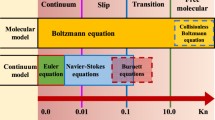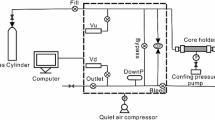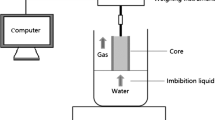Abstract
Shale can act as an unconventional gas reservoir with low permeability and complex seepage characteristics. Study of the apparent permeability and percolation behavior of shale gas is important in understanding the permeability of shale reservoirs, to evaluate formation damage, to develop gas reservoirs, and to design wells. This study simulated methane percolation at 298.15 K under inlet pressures ranging from 0.2 to 4 MPa and a constant outlet pressure of 0.1 MPa to investigate shale gas percolation behavior and apparent permeability. Five representative shale cores from the Carboniferous Hurleg and Huitoutala formations in the eastern Qaidam Basin, China, were analyzed. Each experiment measured the volume flow rate of methane and the inlet pressure. Pseudopressure approach was used to analyze high-velocity flow in shale samples, and apparent permeability at different pressures was calculated using the traditional method. A nonlinear apparent permeability model that considers diffusion and slippage is established from theory and experimental data fitting, and the shale gas flow characteristics affected by slippage and diffusion are analyzed. The results indicate that the pseudopressure formulation that considers the effect of gas properties on high-velocity flow produces a more accurate linear representation of the experimental data. The apparent gas permeability of shale consists of contributions from Darcy permeability, slippage, and diffusion. The apparent permeability and gas flow behavior in the studied shales strongly depended on pressure. The diffusion contribution increased greatly as pressure decreased from 2 to 0.2 MPa, and the smaller the shale permeability, the greater the relative contribution of diffusion flow. At pressures greater than 2 MPa, slip flow contributes \(\sim \)20% of the total flux, Darcy flow contributes up to 70%, and diffusion makes only a minor contribution. This study provides useful information for future studies of the mechanism of shale gas percolation and the exploration and development of Qaidam Basin shale gas specifically.












Similar content being viewed by others
References
Amann-Hildenbrand, A., Ghanizadeh, A., Krooss, B.M.: Transport properties of unconventional gas systems. Mar. Pet. Geol. 31, 90–99 (2012)
Al-Hussainy, R., Ramey Jr., H.J., Crawford, P.B.: The flow of real gases through porous media. J. Pet. Technol. 18(05), 624–636 (1966)
Beskok, A., Karniadakis, G.E.: A model for flows in channels, pipes, and ducts at micro and nano scales. Microscale Thermophys. Eng. 3, 43–77 (1999)
Curtis, M.E., Ambrose, R.J., Sondergeld, C.H., Rai, C.S.: Investigation of the relationship between organic porosity and thermal maturity in the Marcellus shale. In: Paper SPE 144370 presented at the 2011 SPE North American Unconventional Gas Conference and Exhibition, Woodlands, Texas, USA, 14–16 June (2011)
Civan, F.: Effective correlation of apparent gas permeability in tight porous media. Transp. Porous Media 82, 375–384 (2010)
Civan, F., Chandra, S.R., Sondergeld, C.H.: Shale gas permeability and diffusivity inferred by improved formulation of relevant retention and transport mechanisms. Transp. Porous Med. 86, 925–944 (2011)
Chalmers, G.R.L., Ross, D.J.K., Bustin, R.M.: Geological controls on matrix permeability of Devonian Gas Shales in the Horn River and Liard basins, northeastern British Columbia. Canada. Int. J. Coal Geol. 103, 120–131 (2012)
China National Petroleum Company: SY/ T 5336–2006: Practices for Core Analysis. Petroleum Industry Press, Beijing (2006)
Civan, F., Evans, R.D.: Determining the parameters of the Forchheimer equation from pressure-squared vs. pseudopressure formulations. SPE Reserv. Eval. Eng. 1(01), 43–46 (1998)
Chen, F.F., Duan, Y.G., Wang, K., Li, X.D., Liao, Y.: A novel pressure transient response model considering multiple migration mechanisms in shale gas reservoir. J. Nat. Gas Sci. Eng. 22, 321–334 (2015)
Civan, F.: A triple-mechanism fractal model with hydraulic dispersion for gas permeation in tight reservoirs. In: Paper SPE 74368 presented at the 2002 SPE International Petroleum Conference and Exhibition, Villahermosa, Mexico. 10–12 February (2002)
Chen, N.Y., Degnan, T.F., Smith, C.M.: Molecular Transport and Reaction in Zeolites. Wiley, NewYork (1994)
Darabi, H., Ettehad, A., Javadpour, F., Sepehrnoori, K.: Gas flow in ultra-tight shale strata. J. Fluid Mech. 710, 641–658 (2012)
Deng, J., Zhu, W.Y., Ma, Q.: A new seepage model for shale gas reservoir and productivity analysis of fractured well. Fuel 124, 232–240 (2014)
Etminan, S.R., Javadpour, F., Maini, B.B., Chen, Z.X.: Measurement of gas storage processes in shale and of the molecular diffusion coefficient in kerogen. Int. J. Coal Geol. 123, 10–19 (2014)
Freeman, C.M., Moridis, G.J., Blasingame, T.A.: A numerical study of microscale flow behavior in tight gas and shale gas. In: Paper SPE 141125, Presented at the SPE Annual Technical Conference and Exhibition, Florence, Italy, 19–22 September (2011)
Firouzi, M., Alnoaimi, K., Kovscek, A., Wilcox, J.: Klinkenberg effect on prediction and measuring helium permeability in gas shales. Int. J. Coal Geol. 123, 62–68 (2014)
Fathi, E., Tinni, A., Akkutlu, I.Y.: Corretion to Klinkenberg slippage theory for gas flow in nano-capillaries. Int. J. Coal Geol. 10(3), 51–59 (2012)
Ghanizadeh, A., Gasparik, M., Amann-Hildenbrand, A., et al.: Experimental study of fluid transport processes in the matrix system of the European organic-rich shales: I. Scandinavian Alum Shale. Mar. Pet. Geol. 51, 79–99 (2014)
Heller, R., Vermylen, J., Zoback, M.: Experimental investigation of matrix permeability of gas shales. Am. Assoc. Pet. Geol. 98(5), 975–995 (2014)
Howard, J.J.: Porosimetry measurement of shale fabric and its relationship to illite/smectite diagenesis. Clays Clay Miner. 39(4), 355–361 (1991)
Holt, J.K., Park, H.G., Wang, Y.M., Staderman, M., Artyukhin, A.B., Grigoropoulous, C.P., Noy, A., Bakajin, O.: Fast mass transport through sub-2-nanometre carbon nanotubes. Science 312, 134–1047 (2006)
Heidemann, R.A., Jeje, A.A., Mohtadi, F.: An Introduction to the Properties of Fluids and Solids. University of Calgary Press, Calgary (1984)
Javadpour, F., Fisher, D., Unsworth, M.: Nanoscale gas flow in shale sediments. Can. Pet. Technol. 46(10), 55–61 (2007)
Javadpour, F.: Nanopores and apparent permeability of gas flow in mudrocks (shales and siltstone). J. Can. Pet. Technol. 48(8), 16–21 (2009)
Javadpour, F., McClure, M., Naraghi, M.E.: Slip-corrected liquid permeability and its effect on hydraulic fracturing and fluid loss in shale. Fuel 160, 549–559 (2015)
Klinkenberg, L.J.: The permeability of porous media to liquid and gases. API Drill. Prod. Pract. 41, 200–213 (1941)
Kaviany, M.: Principles of heat transfer in porous media. 2ED. New York: Springer. ISBN: 0387945504 (1995)
Loucks, R.G., Reed, R.M., Ruppel, S.C., Jarvie, D.M.: Morphology, genesis, and distribution of nanometer-scale pores in siliceous mudstones of the Mississippian Barnett Shale. J. Sediment. Res. 79, 848–861 (2009)
Landry, C.J., Prodanović, M., Eichhubl, P.: Direct simulation of supercritical gas flow in complex nanoporous media and prediction of apparent permeability. Int. J. Coal Geol. 159, 120–134 (2016)
Li, Y.J., Sun, Y.L., Chang, C., et al.: Prospects of Carboniferous shale gas exploitation in the eastern Qaidam Basin. Acta Geologica Sinica (English Edition) 88, 620–634 (2014)
Liu, C.L., Ma, Y.S., Zhou, G., Yin, C.M., Du, J.J., Gong, W.B.: Evidence for the carboniferous hydrocarbon generation in Qaidam basin. Acta Pet. Sin. 33, 925–931 (2012)
Lv, Q.F., Wang, E.Z., Liu, X.L., Wang, S.J.: Determining the intrinsic permeability of tight porus media based on bivelocity hydrodynetics. Microfluid. Nanofluidics 16, 841–848 (2014)
Mbia, E.N., Fabricius, I.L., Krogsboll, A., Frykman, P., Dalhoff, F.: Permeability, compressibility and porosity of Jurassic shale from the Norwegian-Danish Badin. Pet. Geosci. 20, 257–281 (2014)
Majumder, M., Chopra, N., Andrews, R., Hinds, B.J.: Enhanced flow in carbon nanotubes. Nature 438, 44 (2005)
Mehmani, A., Prodanovic, M., Javadpour, F.: Multiscale, multiphysics network modeling of shale matrix gas flows. Transp. Porous Med. 99, 377–390 (2013)
Ma, Y.S., Yin, C.M., Liu, C.L., Du, J.J., Cheng, H.Y., Fan, T.Y.: The progress of carboniferous oil and gas investigation and assessment in Qaidam basin. Acta Geosci. Sin. 33, 135–144 (2012)
Mehmani, Ayaz: Prodanović, Maša: The application of sorption hysteresis in nano-petrophysics using multiscale multiphysics network models. Int. J. Coal Geol. 128, 96–108 (2014a)
Mehmani, A: A pore scale analysis of restricted diffusion in shale gas media. In: Unconventional Resources Technology Conference (URTEC) (2014b)
Mason, E.A., Malinauskas, A.P.: Gas Transport in Porous Media: The Dusty-gas Model. Elsevier Science, Amsterdam (1983)
Niu, C., Hao, Y.Z., Li, D.L., Lu, D.T.: Second-order gas-permeability correlation of shale during slippage flow. Soc. Pet. Eng. SPE J. Paper 168226(19), 786–792 (2014)
Naraghi, M.E., Javadpour, F.: A stochastic permeability model for the shale-gas systems. Int. J. Coal Geol. 140, 111–124 (2015)
Roy, S., Raju, R., Chuang, H.F., Cruden, B.A., Meyyappan, M.: Modeling gas flow through microchannels and nanopores. J. Appl. Phys. 93(8), 4870–4879 (2003)
Sakhaee-Pour, A., Bryant, S.: Gas permeability of shale. SPE Reserv. Eval. Eng. 15(4), 401–409 (2012). doi:10.2118/146944-PA
Singh, H., Javadpour, F.: Langmuir slip-Langmuir sorption permeability model of shale. Fuel 164, 28–37 (2016)
Shabro, V., Torres, V.C., Javadpour, F.: Numerical simulation of shale-gas production: from pore-scale modeling of slippage-flow, knudsen diffusion and Langmuir desorption to reservoir modeling of compressible fluid. In: Paper SPE 144355 Presented at the 2011 SPE North American Unconventional Gas Conference and Exhibition, The Woodlands, Texas, USA, 14–16 June (2011)
Scheidegger, A.E.: The Physics of Flow through Porous Media, 3ED. University of Toronto Press, Toronto (1974)
Tanikawa, W., Shimamoto, T.: Comparison of Klinkenberg-corrected gas permeability and water permeability in sedimentary. Min. Sci. 46, 229–338 (2009)
Tang, G.H., Tao, W.Q., He, Y.L.: Gas slippage effect on microscale flow using the lattice Boltzmann method. Phys. Rev. E. 72, 056301 (2005)
Vivek, S.M. Wami, Settari, A.: A pore scale gas flow model for shale gas reservoir. In: Paper SPE 155756 Presented at the 2012 SPE American Unconventional Resources Conference, Pittsburgh, Pennsylvania, USA, 5–7 June (2012)
Wang, F.P., Reed, R.M.: Pore networks and fluid flow in gas shales. Paper SPE 124253 Presented at the 2009 SPE Annual Technical Conference and Exhibition, New Orleans, LA, USA, 4–7 October (2009)
Wang, Y.J., Wang, C.J., Gao, J.B.: A research of Gas slippage in low permeability porous media. Acta Pet. Sin. 16(3), 101–105 (1995)
Wei, H.G., Yue, X.A., Zhang, L., Ma, G.L., li, L.: Experimental method to measure permeability of rock with super-low permeability. Pet. Geol. Oilfield Dev. Daqing 30(3), 93–96 (2011)
Wu, Y.S., Pruess, K., Persoff, P.: Gas flow in porous media with Klinkenberg’s effect. Transp. Porous Media. 32, 117–137 (1998)
Wang, D.K., Wei, J.P., Fu, Q.C., Liu, Y., Xia, Y.L.: Percolation law and permeability calculation of coal gas based on Klinkenberg effect. J. Cent. South Univ 22, 1973–1978 (2015)
Zhang, W.-M., Meng, G., Wei, X.: A review on slip models for gas microflows. Microfluid. Nanofluidics 13(6), 845–882 (2012)
Acknowledgements
This study was financially supported by the National Nature Science Foundation of China (Nos. 40772208 and 41272387), and the China Geological Survey program (Nos. 20120113040000-3 and 1212011120964) is gratefully acknowledged.
Author information
Authors and Affiliations
Corresponding author
Rights and permissions
About this article
Cite this article
Gao, J., Yu, Q. & Lu, X. Apparent Permeability and Gas Flow Behavior in Carboniferous Shale from the Qaidam Basin, China: An Experimental Study. Transp Porous Med 116, 585–611 (2017). https://doi.org/10.1007/s11242-016-0791-y
Received:
Accepted:
Published:
Issue Date:
DOI: https://doi.org/10.1007/s11242-016-0791-y




